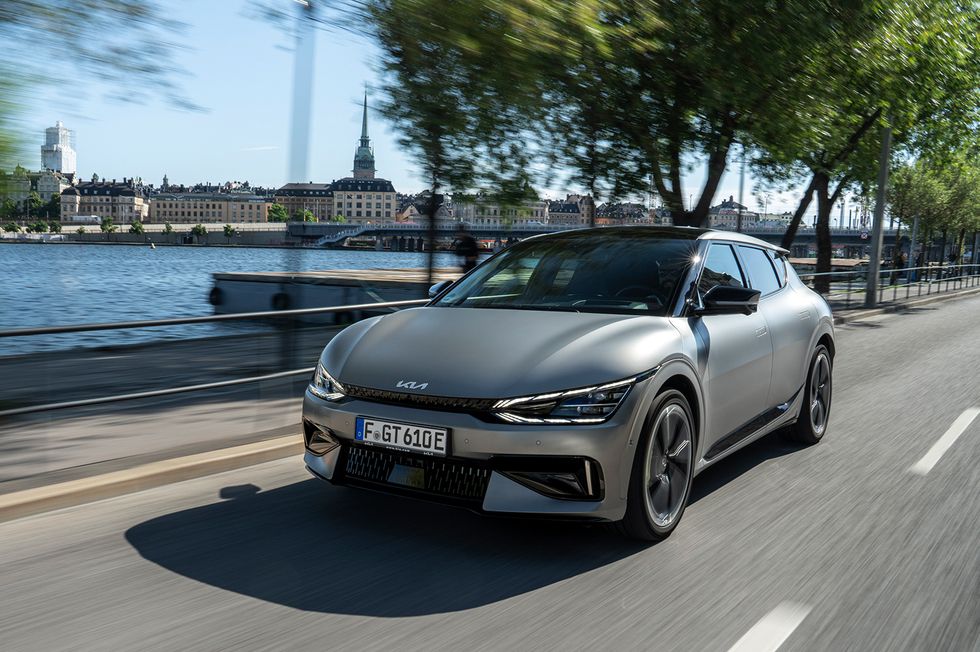2023 Kia EV6 GT Is the Quickest Kia Yet

The new Kia EV6 GT is set to find itself in some very distinguished company. The turned-up version of Kia’s mid-size electric crossover is a zero-emission muscle car with horsepower output that beats some much pricier offerings. This family hauler cranks out 576 horsepower across its two motors, which should deliver a 60-mph time in the low threes. And while most electric cars have speed limiters set low for reasons of both range and sensibility, the EV6 GT is capable of 161 mph. Also, it has a drift mode.
Riding on Hyundai-Kia’s highly advanced E-GMP platform, the GT promises to be impressively svelte by the pudgy standards of its segment, tipping the scales at a claimed 4780 pounds. Moreover, this platform can deliver ultraquick DC fast-charging rates of up to 240 kW—sufficient to replenish the relatively small 77.4-kWh battery pack from 10 to 80 percent in 18 minutes at a 350-kW DC fast-charge station, according to Kia.
Next to the all-wheel-drive EV6 GT-Line that sits just below the EV6 GT in the hierarchy, visual distinction is limited; the GT definitely doesn’t shout about its extra performance. The front and rear bumpers have been subtly changed, 21-inch wheels are standard (necessary to fit around larger brake discs), and a liftgate spoiler is fitted. Inside, the GT gets semi-bucket sports seats trimmed in microfiber, some new performance touchscreen displays, and, on the steering wheel, a GT button that accesses the new Dynamic mode, which joins the regular Eco, Normal, and Sport settings.
Mechanical changes are more significant. The GT is powered by significantly brawnier motors than the current all-wheel-drive EV6, with the one at the front now having a maximum output of 215 horsepower and the rear unit making up to 362 horsepower. The rear axle also features a torque-biasing differential that varies the amount of thrust sent to each wheel, and the rear motor adds another bit of leading-edge EV tech, a two-stage inverter that uses silicon-carbide semiconductors. This improves efficiency by up to 3 percent while also reducing heat generated when the motor is working harder. As in other high-performance EVs, output is restricted in lesser drive modes: Eco limits the system peak to 288 horsepower, while Normal and Sport lift that to 460. Only GT mode unleashes the full 576 ponies.
The result is a seriously quick car. As in the existing EV6, the GT has a relatively gentle accelerator response at the top of the pedal’s travel. (This is especially obvious in the likely little-used Eco mode, which seems to add an inch of deadness to the top of the accelerator.) But pushing the pedal harder quickly summons forceful thrust, and a standing launch in GT mode creates g-forces that relocate internal organs as the rear tires battle to find traction.
This was on the dry asphalt of a Swedish test track and despite Kia’s fitment of performance Michelin Pilot Sport 4S tires rather than low-rolling-resistance rubber. In Europe, Kia claims a 0-to-62-mph time of 3.5 seconds, but we suspect that the result for our benchmark 60 mph will be even better. (Our 60-mph time for the 320-hp all-wheel-drive version was 4.5 seconds.)
Pressing the GT button on the steering wheel also unlocks the further option of the drift mode. This, you will be entirely unsurprised to hear, is huge fun—even if it’s hard to imagine too many EV6 buyers making even occasional use of it. Kia gave us the chance to experience the system on a skidpad, where it allowed the GT to be easily persuaded into impressive angles of power oversteer, with invisible intervention from the smart rear differential and assistance from the front motor helping to maintain them as speed rises. If nothing else, the ability to smoke tires is an indication of the potency of the most powerful car Kia has ever produced.
But it is at speeds more appropriate for the real world that the active diff impressed more. The ability to send more torque to the outside rear wheel not only helps the car turn in, but also gives a sense of rear-led handling when GT mode is selected. That makes the GT feel exciting well short of any loss of grip. As in lesser EV6s, the steering is precise and direct, although little low-level feedback gets past the weighty assistance.
Ride quality was very impressive. The GT gets adaptive dampers as standard, and even in their firmer mode, they handle bumps and dips with assured compliance. Although the GT has stiffer springs, there’s still discernible roll under cornering. Cruising refinement is excellent. We didn’t confirm the claimed 161-mph top speed on Sweden’s well-policed highways (it’s a nation where traveling 5 km/h over the posted limit feels daring), but at highway velocities, the GT’s cabin was snug and well insulated.
